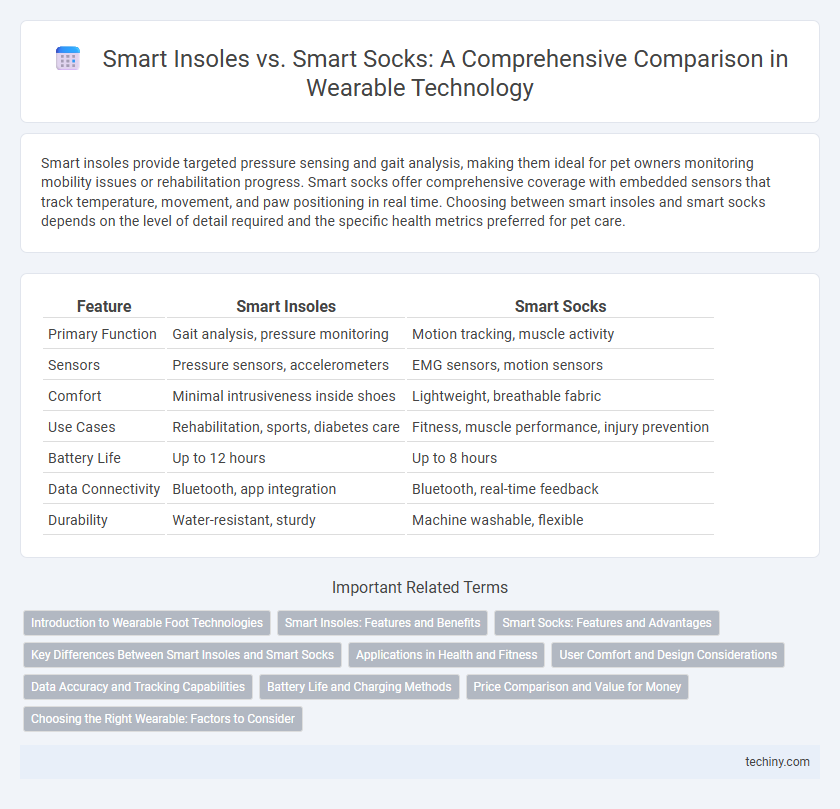Smart insoles provide targeted pressure sensing and gait analysis, making them ideal for pet owners monitoring mobility issues or rehabilitation progress. Smart socks offer comprehensive coverage with embedded sensors that track temperature, movement, and paw positioning in real time. Choosing between smart insoles and smart socks depends on the level of detail required and the specific health metrics preferred for pet care.
Table of Comparison
| Feature | Smart Insoles | Smart Socks |
|---|---|---|
| Primary Function | Gait analysis, pressure monitoring | Motion tracking, muscle activity |
| Sensors | Pressure sensors, accelerometers | EMG sensors, motion sensors |
| Comfort | Minimal intrusiveness inside shoes | Lightweight, breathable fabric |
| Use Cases | Rehabilitation, sports, diabetes care | Fitness, muscle performance, injury prevention |
| Battery Life | Up to 12 hours | Up to 8 hours |
| Data Connectivity | Bluetooth, app integration | Bluetooth, real-time feedback |
| Durability | Water-resistant, sturdy | Machine washable, flexible |
Introduction to Wearable Foot Technologies
Smart insoles and smart socks represent innovative wearable foot technologies designed to monitor gait, pressure, and foot health through embedded sensors. Smart insoles offer customizable support and real-time data collection for athletes and patients with mobility issues, while smart socks provide seamless integration with everyday footwear and continuous biometric tracking. Both technologies leverage advanced materials and connectivity to enhance comfort, injury prevention, and performance optimization.
Smart Insoles: Features and Benefits
Smart insoles offer advanced pressure sensors, real-time gait analysis, and customizable support to enhance foot health and athletic performance. Embedded with Bluetooth connectivity, they provide seamless data syncing to mobile apps for personalized feedback and injury prevention. Enhanced durability and ergonomic design ensure all-day comfort and precise motion tracking for various activities.
Smart Socks: Features and Advantages
Smart socks incorporate advanced sensors that monitor foot pressure, temperature, and gait patterns in real-time, offering precise biomechanical insights for injury prevention and performance enhancement. These socks provide enhanced comfort and seamless integration with footwear, making them ideal for athletes and individuals requiring continuous foot health monitoring. Their washable, durable fabric ensures long-term use without compromising sensor accuracy or user convenience.
Key Differences Between Smart Insoles and Smart Socks
Smart insoles integrate pressure sensors and accelerometers to provide detailed gait analysis and real-time feedback on foot alignment, enhancing injury prevention and performance monitoring. Smart socks incorporate conductive fibers to measure metrics like temperature, moisture, and muscle activity, offering insights into foot health and sweat levels. While smart insoles are typically inserted into footwear for structural data, smart socks deliver holistic biometric information through seamless fabric integration.
Applications in Health and Fitness
Smart insoles provide precise gait analysis and pressure distribution data, enhancing injury prevention and rehabilitation in health and fitness monitoring. Smart socks offer continuous biometric tracking, including heart rate and muscle activity, promoting optimized workout performance and recovery. Both wearable technologies support personalized health insights but differ in sensor placement and data specificity tailored to user needs.
User Comfort and Design Considerations
Smart insoles offer customizable arch support and pressure sensors designed to enhance user comfort through personalized fit and shock absorption, while smart socks incorporate seamless knitting techniques and breathable fabrics to reduce friction and improve moisture management. Both devices prioritize ergonomic design, but smart socks emphasize lightweight materials and flexibility for extended wear, whereas smart insoles focus on impact resistance and durability within diverse footwear. Advances in sensor integration in smart socks enable real-time gait analysis without compromising comfort, contrasting with smart insoles' bulkier profile that may affect fit in tighter shoe models.
Data Accuracy and Tracking Capabilities
Smart insoles provide precise pressure mapping and gait analysis through embedded sensors, enabling accurate tracking of foot biomechanics and real-time feedback for injury prevention. Smart socks incorporate flexible fibers and accelerometers to monitor motion and physiological data but may sacrifice some accuracy due to fabric movement and sensor placement variability. Overall, smart insoles tend to offer superior data accuracy and detailed tracking capabilities compared to smart socks, especially in clinical or athletic performance settings.
Battery Life and Charging Methods
Smart insoles typically offer longer battery life, ranging from 8 to 12 hours of continuous use, thanks to larger built-in batteries, while smart socks usually provide around 6 to 8 hours due to their lightweight design constraints. Smart insoles commonly use USB charging docks or wireless charging pads that allow convenient recharging without removing the device entirely. In contrast, smart socks often rely on detachable battery modules or quick-charge USB ports integrated into a small control unit to maintain flexibility and comfort during wear.
Price Comparison and Value for Money
Smart insoles typically range from $100 to $250, offering advanced pressure mapping and gait analysis features, while smart socks generally cost between $50 and $150, providing basic biometric tracking such as temperature and moisture levels. Despite the higher price, smart insoles deliver greater value for money through detailed posture correction and injury prevention capabilities favored by athletes and rehabilitation patients. Consumers seeking affordable, everyday comfort monitoring might find smart socks a cost-effective option but with limited functionality compared to smart insoles.
Choosing the Right Wearable: Factors to Consider
When choosing between smart insoles and smart socks, consider factors like sensor accuracy, comfort, and specific use cases such as gait analysis or injury prevention. Smart insoles often provide detailed pressure and balance data ideal for athletes or rehabilitation, while smart socks offer seamless integration and ease of use for everyday activity tracking. Battery life, durability, and compatibility with mobile apps also play crucial roles in selecting the most effective wearable technology for your needs.
Smart Insoles vs Smart Socks Infographic

 techiny.com
techiny.com